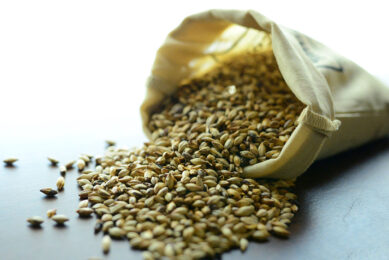Don’t underestimate the risk of masked mycotoxins
![The toxic effects induced by DON are well characterised in most production animals, with pigs being the most susceptible.<br />[Photo: Koos Groenewold]](https://www.allaboutfeed.net/app/uploads/2020/12/001_16_rb-image-2787532.jpeg)
[Photo: Koos Groenewold]
Masked mycotoxins can escape detection by routine analytical methods, leading to an underestimation of the degree of contamination. Metabolites of DON, one of the most prevalent toxins, can create increased risks in the digestive tracts of animals.
Mycotoxins are toxic fungal metabolites that can contaminate a wide array of crops. The most frequently occurring mycotoxins with well-known toxic effects are:
- aflatoxins (AFL),
- trichothecenes (TCT),
- fumonisins (FUM),
- zearalenone (ZEA) and
- ochratoxins (OT)
One of the most important mycotoxin producing fungi are those of the Fusarium genus, which typically produce mycotoxins on the crops while still in the field. Fusarium fungi can produce several toxins of which the trichothecenes (including deoxynivalenol (DON) and T-2 toxin), FUM and ZEA are the most important based on occurrence and toxicity. Of these, DON is the most prevalent. It is typically found in wheat, barley, corn, rye, oats, and thus also in compound feeds of production animals.
The toxic effects induced by DON are well characterised in most production animals, with pigs being the most susceptible, for which the lowest guidance value of 0.9 ppm in complete feed was established.
Occasionally, manifested clinical symptoms due to intake of mycotoxin-contaminated feed are more serious than expected based on analytical results. This has led to the discovery of masked mycotoxins which escape detection by routine analytical methods. Consequently, this can lead to an underestimation of the degree of contamination upon analysis.
Metabolites of DON include 3-acetyl-DON (3ADON), 15-acetyl DON (15ADON) and deoxynivalenol-3-β-D-glucoside (DON3G). These metabolites can have a direct toxic effect, or can be hydrolysed to DON in the digestive tract of animals, resulting in higher exposure levels to DON. At this moment, there are no directives, regulations nor recommendations in food or feed taking these derivatives of DON into account.
An overview of the occurrence of DON and its metabolites as shown in Table 1 originates from 13 reports published between 2010 and 2014 on wheat, maize, barley, oat and rye. As can be seen, the level of incidence is not negligible and thus their presence should not be ignored.
Toxicity and toxicokinetics
Following oral intake of DON and its acetylated metabolites, the intestinal mucosa will be exposed first. This barrier to foreign antigens is composed of intestinal epithelial cells which are interconnected by tight junctions. It was demonstrated that DON and its metabolites are able to increase the permeability of the intestinal epithelial layer by decreasing the expression of tight junction proteins. Further, a reduction in cell proliferation was demonstrated. Together, these actions increase the animal’s susceptibility to pathogens. Another point of concern is the co-contamination of DON with other mycotoxins and metabolites of DON, and their potentially synergistic effects.
Trichothecenes are rapidly absorbed and excreted without accumulation in any tissue, and only traces of the toxins are found 24 hours after oral exposure. The main route of excretion is the urine, and only a small fraction is excreted in the faeces. Once ingested, in pigs 3ADON and 15ADON are rapidly hydrolysed to DON (1) and detected in blood shortly after oral exposure to these toxins (2), see Figure 1. Most of the ingested (A)DON is absorbed before microbial de-epoxydation to the non-toxic metabolite (A)DOM-1 can effectively take place further in the gut.
Figure 1 – Metabolism of DON in pigs.

In plasma, a significant portion of total DON is conjugated (3). This is considered as a detoxification pathway which increases the water solubility, thereby facilitating the excretion of the toxin via urine and bile (4a, 5). Also low levels of (conjugated) DOM-1 are detected in plasma which are probably derived from the gut, either from biliary excretion of (conjugated) DON (4a) and subsequent de-epoxidation (4b) and absorption (4c) of de-epoxy-DON which possibly entered the systemic circulation (4d) after passage through the liver. This process is called entero-hepatic cycling.
In contrast to the acetylated metabolites of DON, little is known about the toxicity and toxicokinetics of DON3G.
Reducing negative effects of contaminated feed
An in vivo trial was set up to investigate the ability of Free-Tox to prevent or reduce the negative effects when pigs were fed a diet contaminated with a natural mixture of DON, 3ADON and 15ADON. A total of 120 piglets, weaned at 3.5 weeks old, were assigned to 20 pens. The piglets were assigned to 1 out of 4 dietary treatments: (T1) control uncontaminated diet, (T2) uncontaminated diet + 1 g Free-Tox per kg feed, (T3) contaminated diet and (T4) contaminated diet + 1 g Free-Tox per kg feed. From day 1 until 14 of the experiment, the diet was contaminated with 3 ppm of a mixture of DON (2.6 ppm), 3ADON (0.1 ppm) and 15ADON (0.3 ppm), after which the contamination level was reduced to 1 ppm from day 15 until 37.
Figure 2 – Weight gain & FCR (Day 0-14).
During the first 14 days of the experiment, the pigs that received the DON-contaminated feed without Free-Tox (T3) consumed significantly less feed when compared to pigs that received the same DON-contaminated feed with Free-Tox (T4) (227 vs 272 g/d; P=0.039) which resulted in significant growth depression (159 vs 205 g/d; P=0.024) (Figure 2). From day 15 until 37 and over the total experimental period, the same trend was seen when compared to the first 14 days (Figure 3).
Figure 3 – Weight gain & FCR (Day 0-37).
In conclusion, Free-Tox could largely prevent or eliminate the negative effects induced by DON and its metabolites and this led to a clear improvement in the overall growth performance.
References available upon request
Join 26,000+ subscribers
Subscribe to our newsletter to stay updated about all the need-to-know content in the feed sector, three times a week. Beheer
Beheer











 WP Admin
WP Admin  Bewerk bericht
Bewerk bericht